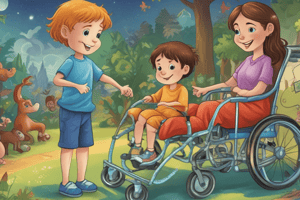Podcast
Questions and Answers
What is the primary cause of spastic subtypes of cerebral palsy?
What is the primary cause of spastic subtypes of cerebral palsy?
Damage to the cerebral cortex
Which part of the brain is damaged in individuals who develop athetosis?
Which part of the brain is damaged in individuals who develop athetosis?
Basal ganglia
What type of cerebral palsy results from damage to the cerebellum?
What type of cerebral palsy results from damage to the cerebellum?
Ataxia
How can you classify cerebral palsy in terms of body part involvement?
How can you classify cerebral palsy in terms of body part involvement?
What is the importance of postural control in children with cerebral palsy?
What is the importance of postural control in children with cerebral palsy?
What is the cause of ataxia in cerebral palsy?
What is the cause of ataxia in cerebral palsy?
What is the impact of lack of postural control in a child with cerebral palsy?
What is the impact of lack of postural control in a child with cerebral palsy?
How does lack of mobility and weightbearing affect digestion in children with cerebral palsy?
How does lack of mobility and weightbearing affect digestion in children with cerebral palsy?
What are some areas of life affected by upper motor neurons Aetiology in individuals?
What are some areas of life affected by upper motor neurons Aetiology in individuals?
How can adaptive equipment help individuals with cerebral palsy?
How can adaptive equipment help individuals with cerebral palsy?
What are some examples of physical care tasks that may be challenging for individuals with cerebral palsy?
What are some examples of physical care tasks that may be challenging for individuals with cerebral palsy?
Why is postural control important for children with cerebral palsy?
Why is postural control important for children with cerebral palsy?
Flashcards are hidden until you start studying
Study Notes
- The content discusses Cerebral Palsy, covering its definition, causes, clinical signs, subtypes, impact on emotional, educational, care, and physical aspects, postural control, and resources for parents.
- Cerebral Palsy can be classified based on involvement of body parts and muscle tone, with different subtypes like spastic, athetosis, and ataxia caused by damage to specific brain areas.
- The emotional impact of Cerebral Palsy includes effects on self-confidence, social environment, while education-related impacts involve reading, writing, and classroom mobility, with therapy and adaptive equipment being crucial.
- In terms of care, Cerebral Palsy affects transportation, walking, carrying, standing, feeding, sitting, sleeping, toileting, and bathing.
- Postural control is vital in children with Cerebral Palsy to prevent misalignment of body structures, respiratory issues, contractures, dislocations, digestive problems, and constipation.
Studying That Suits You
Use AI to generate personalized quizzes and flashcards to suit your learning preferences.




